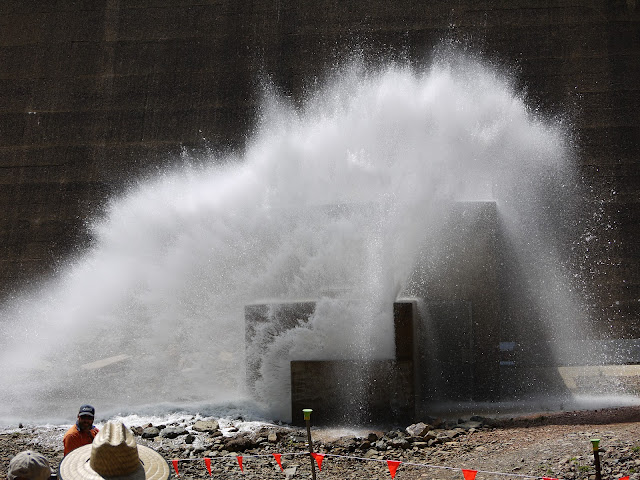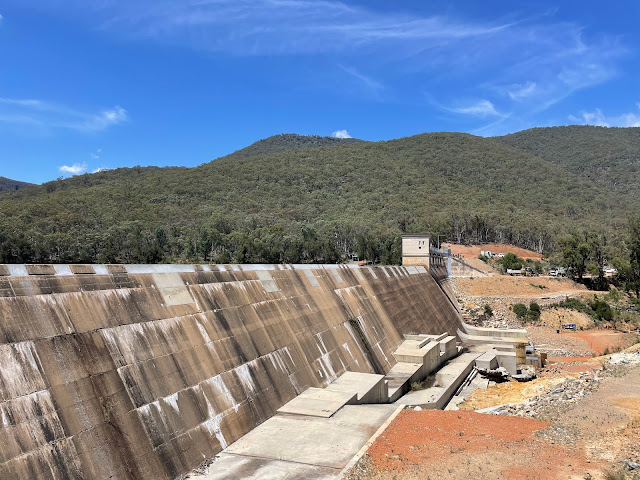Last week we joined in on a tour of Winburndale Dam, which is the secondary water supply for Bathurst. The significance of this is that there is no public access to the site. Over the last few years there has been a major upgrade to the infrastructure and our local council arranged for two bus loads of people to go and see what has been done. We jumped at the chance and were lucky enough to get a seat. Many people that would like to have gone along missed out. As the tour was on a Wednesday, the participants were mainly retirees, as most people are at work. It was a really hot day.
To access the dam you drive along some narrow dirt roads (excuse the reflections) and finally into the Winburndale Nature Reserve. Despite there being no public access, several people on the tour had managed to access the site at some stage of their lives, by dirt bike riding, horse riding, hiking or with previous rangers.
A little history:
The dam construction started in 1931 as a works project during the great depression and came into operation in 1934. It is located up in the hills east of Bathurst on the Winburndale Rivulet. The water is gravity fed to Bathurst and originally ran through pipes made of timber. The timber pipes were constructed in a manner similar to barrels. Some of those pipes are still functional.
It is fairly small, holding just 1,700 megalitres. By comparison, Ben Chifley Dam, our main water supply, holds 30,800 megalitres.
The water is used to keep our parks, gardens and sporting fields watered and does not run through the water treatment plant for drinking.
Back to now:
After checking, it was obvious that although the dam wall has had no issues, it did not meet current safety guidelines and at 90 years old, things would need some upgrading. 16 million dollars has been spent on the upgrade and it ended up being a much bigger project than anticipated. All work was carried out by a local engineering firm, using local contractors wherever possible, which is commendable.
Our deputy mayor decided that it would be good if the locals could see where the money had been spent. When we arrived, there was a little speech from him and our local state MP, who declared this to be the unofficial official opening, as there wouldn't be an official one.
L to R: Ben Fry (Deputy Mayor), Ian McCartney (former Winburndale Ranger for 20 years), Paul Toole, State MP.
So what did they do? (As well as my photos, I will add some from photo boards on the day that showed the actual works in progress.)
Mick, having worked on construction and industrial sites for his entire working life, and being the one to figure out how to do tricky jobs, was fascinated. He reckons it would have been a great project to be involved with and had a good chat with our guide, who had been one of the main project managers. He is pictured here with the original valve, which was replaced.
Firstly, they had to dig down to check the foundations below the dam wall. It transpired that the wall was not built on solid rock and they had to dig down about 8 metres to reach it, much of it by hand, so as not to damage the wall. The wall itself had been well built. From that depth they had to concrete up to the base of the dam wall to provide a solid base.
About 700 truck loads of concrete, all to very specific, strong specifications, had to be delivered to site, which is about a 45 minute drive from town.
The water is piped through the wall at the tower. The cast iron pipes had to be checked to see what condition they were in. To access them, a large metal plate had to be attached to the side of the dam wall, within the dam to stop the water flow, this job being carried out by specialist divers. The pipes turned out to be in rather good condition. Those that were accessible were removed and refurbished, rather than replaced, as they knew they would fit and be water tight.
There is a mechanism that lifts the inlet pipe up and down to get the best quality water from the dam. That was originally manually operated. It has now been upgraded to be automated. There is a well that goes to the bottom of the dam wall in here, so that the pipes can be accessed.
There are two outlets, one is the pipe that goes to town and the other is one that can be opened to let extra water out, directly down the creek, as required. This one is tested once a month and they opened it while we were there. This originally had just one valve, which has now been replace with three for additional safety. Some water is still directed down the creek at all times.
The entire wall of the dam is the spillway and had a timber walkway across it to the tower.
That walkway has been replaced by a metal mesh one and raised by 1300mm to be above the one in one thousand year flood level. The floor of the room in the tower was also raised that amount.
The main strengthening that was carried out was adding pretensioned rods down through the height of the wall. (Where you can see the new paler concrete at the top of the wall.) At its highest, the wall is 25 metres. The rods had to go into the ground to the same depth, so some were over 50 metres long.
They had to be craned into place, vertically above the wall, without bending and had then to be placed in predrilled holes in the wall with tolerances of only 10mm.
The local firm did all the work. as no one else would take it on.
As challenges arose, the engineers had to problem solve and work out how to approach them. For example, they had to get drilling rigs and pretensioning machines out onto the top of the wall, which is only quite narrow. Therefore they built a wider platform over the entire length of the wall that would take the weight of heavy equipment.
Added to this, throughout the time of the project, there were a couple of flooding events, during which they had to move all their gear out of harm's way and had subsequent delays.
It was such an interesting tour and one we feel privileged to go on. Congratulations on the Council for arranging it. After all that walking, mainly in the very hot sun, we were all pleased to get back into the air conditioned busses for the trip back to town.


















10 comments:
It's always interesting to see how thee projects are done, and of course if your mind turns to engineering Stuff it would be even more so.
What an interesting post! Thanks for sharing the tour; super informative! :)
Looks like an interesting day out for you both. I have just spent quite some time going way back and catching up on your blog posts, and you have been very busy and productive on the touring and the stitching fronts. Well done. Not too much stitching happening here lately.
What a great day out for you, it was very interesting, how things are fixed and problems solved.
I forgot to ask, did the retired ranger have a snake catching stick in his hand??
What an interesting tour. I am glad to hear that a local firm was employed o do the work.
How interesting... great to have had that experience.
Hugz
another totally interesting blog....
Thanks for sharing. So interesting and what a treat you got to go. My birth name was McCartney wonder if he's a long distance relly lol!
fascinating.......never even knew there was another water supply.........
Post a Comment